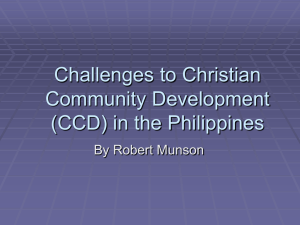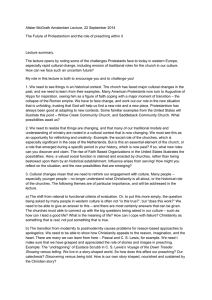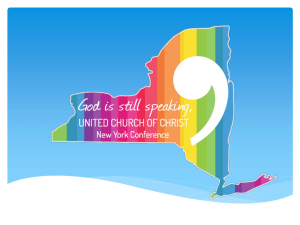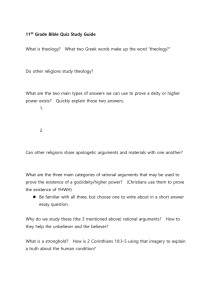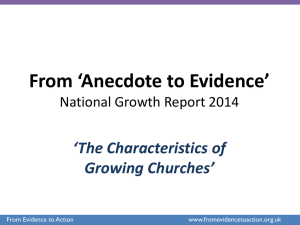Congregational - National Library of Australia
advertisement
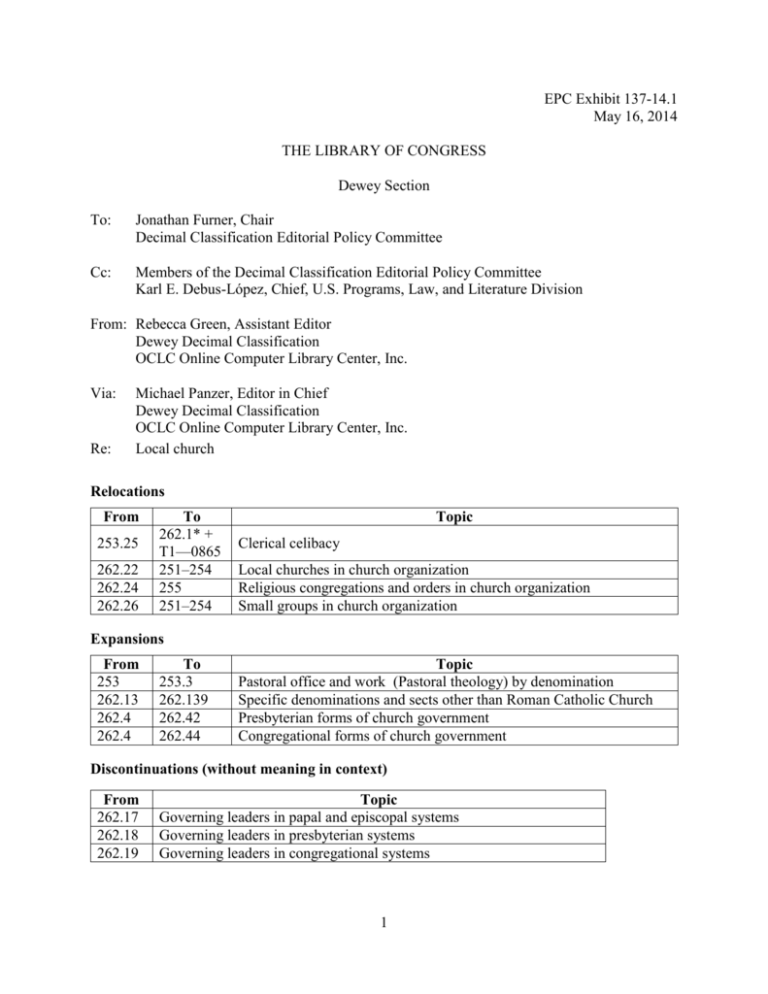
EPC Exhibit 137-14.1
May 16, 2014
THE LIBRARY OF CONGRESS
Dewey Section
To:
Jonathan Furner, Chair
Decimal Classification Editorial Policy Committee
Cc:
Members of the Decimal Classification Editorial Policy Committee
Karl E. Debus-López, Chief, U.S. Programs, Law, and Literature Division
From: Rebecca Green, Assistant Editor
Dewey Decimal Classification
OCLC Online Computer Library Center, Inc.
Via:
Re:
Michael Panzer, Editor in Chief
Dewey Decimal Classification
OCLC Online Computer Library Center, Inc.
Local church
Relocations
From
253.25
262.22
262.24
262.26
To
262.1* +
T1—0865
251–254
255
251–254
Topic
Clerical celibacy
Local churches in church organization
Religious congregations and orders in church organization
Small groups in church organization
Expansions
From
253
262.13
262.4
262.4
To
253.3
262.139
262.42
262.44
Topic
Pastoral office and work (Pastoral theology) by denomination
Specific denominations and sects other than Roman Catholic Church
Presbyterian forms of church government
Congregational forms of church government
Discontinuations (without meaning in context)
From
262.17
262.18
262.19
Topic
Governing leaders in papal and episcopal systems
Governing leaders in presbyterian systems
Governing leaders in congregational systems
1
In response to an early draft of EPC Exhibit 136A-13.4 Parishes (in which “parish” terminology
was replaced by “local church” terminology), Guido Bee, Deutsche Nationalbibliothek (DNB),
shared the following:
For us, a difficulty lies in the differentiation of local church in a more generic and in a more
concrete sense.
In 2009, as we had heard that a restructuring of Christian Theology was intended for DDC
23, we have made some recommendations, e. g.: “Usually academic Theology is divided
into four major disciplines: Biblical Theology, Church History, Systematical Theology and
Practical Theology. While it’s uncomplicated to locate Biblical Theology (220-229),
Church History / Historical Theology (270-279) and Systematical Theology (230-239),
Practical Theology is divided into different parts of DDC 250/260, so the [corresponding]
subdisciplines are separated from each other: Pastoral Theology at 250, 253, 259 and 262,
Religious education / Catechetics at 268, Homiletics at 251, Liturgy at 264 and Church Law
at 262.9. Especially works on Pastoral Theology – despite Manuel Note 260 vs. 251-254,
259 – are currently quite scattered. Perhaps it would be useful to consider this at the next
revision.”
In our daily work, especially the allocation of literature with the topic “parish” to 253 or
262 is often a stumbling block. We have a lot of works which treat not only the
abstract/generic meaning of local churches, but also the concrete/specific meaning, e. g., in
works about parish renewal. In these cases, Manual Note 260 vs. 251-254, 259 doesn’t
help. We often consult WorldCat, but there we find a very inconsistent treatment of this
topic, too. So, if we had the choice, we would prefer to have only one DDC number for
local church theory and concrete activities of local churches.
In the final exhibit, we reported DNB’s comments, plus the following:
Michael Cantlon, Dewey classifier at the Library of Congress, confirms the general picture
painted by DNB.
We therefore anticipate further work in the future in this area—possibly adding notes in the
schedules and almost certainly revising the Manual note at 260 vs. 251-254, 259—to clarify
which topics should be classed in which numbers.
This exhibit is that “further work in the future.” It addresses: (1) the treatment of practical
theology, (2) lack of clarity in the classification of topics found in both the 250s and the 260s, (3)
treatment of systems/forms of church government (262.17–262.19; 262.3–262.4), and (4)
treatment of governing leaders of churches (262.12–262.15). Because of the variety of issues
addressed and the complexity of the exhibit, specific proposals are given in italics to facilitate
review on the part of the reader.
Issue 1. Practical theology
Although practical theology is an important top-level category in the academic study of
Christianity, it is absent from the DDC, except for the PPT mapping of the LCSH “Theology,
Practical” to 230. (Good thing it’s only a PPT mapping! Systematic theology is at 230, not
2
Practical theology, which ranges over 240, 250, and 260.) The table below shows the LCSHs
that are narrower terms of “Theology, Practical” and the DDC classes they correspond to.
Narrower LCSHs of “Theology, Practical”
Christian education
Christian life
Church management
Church societies
Church work
Devotional exercises
Ecclesiastical law
Evangelistic work
Fasts and feasts
Missions
Worship
Corresponding DDC number
268
248.4
254
267
253, 259
242
262.9
269.2
263
266
248.3, 264
We propose to add a class-here note for comprehensive works on practical theology at 260
(where comprehensive works on Christian church are already found) and to add a see reference
from there to 240 for moral and devotional theology (the class description at 260 already
contains a see reference to 250 for local church and religious orders).
Issue 2. Topics found in both the 250s and the 260s
Tension between the 250s and 260s is most evident in three areas:
a. 250 Local Christian church and Christian religious orders vs. 262.2 [Ecclesiology] Local
church and religious congregations and orders in church organization
b. 253 Pastoral office and work (Pastoral theology) vs. 262.14 [Ecclesiology] Local clergy,
262.15 [Ecclesiology] Laity
c. 259 Pastoral care of families, of specific groups of people vs. 261.832 [Christianity and
socioeconomic problems] Social welfare problems and services, 261.835 Family
a. 250 Local Christian church and Christian religious orders vs. 262.2 Local church and
religious congregations and orders in church organization
A see reference draws off 250 Local Christian church and Christian religious orders from 260
Christian social and ecclesiastical theology. Consistent with the broader scope of 260, the
Manual note at 260 vs. 251–254, 259 for Christian social and ecclesiastical theology vs. Local
church and Pastoral care of specific kinds of persons carries the general instruction, “If in doubt,
prefer 260.” Our task then is not so much that of identifying a dividing line between the 250s
and the 260s as it is of better clarifying the specific set of topics drawn off from the 260s and
meant to be classed in the 250s.
One area where this is exceptionally difficult concerns 262.2 Local church and religious
congregations and orders in church organization. For the most part, the local Christian church
and Christian religious orders are drawn off to the 250s, but those aspects that concern church
3
organization (that is, church government as a whole) are retained in 262.2. The obvious intent is
to keep all works on church organization / church government as a whole together in 262. We
note further that 254 Local church administration is drawn off from 262.2, as is the government
and administration of religious congregations and orders, which is to be classed in 255 Religious
congregations and orders. What remains at 262.2 is then very narrow and is difficult to
characterize. LC classifier Michael Cantlon indicates that he rarely uses these numbers. We
imagine that users would find it more appropriate if (a) the local church and (b) religious
congregations and orders were drawn off from 260 in their entirety, that is, if all works on the
local church were classed in 251–254 Local church and all works on religious congregations and
orders were classed in 255 Religious congregations and orders. We therefore propose to relocate
the subdivisions of 262.2 to 251–254 Local church and 255 Religious congregations and orders,
as appropriate (even though the literary warrant at 262.2 [3281], especially at 262.22 [2337], is
considerable). We also propose to replace the third paragraph in the Manual note at 260 vs.
251–254, 259, a paragraph that deals most generally with the use of 260 vs. 250, with the
following paragraph:
Use 260 for works on the church as a whole and for comprehensive works on the church as a
whole and the local church. Use 250 for works intended for the individual practitioner in the
local setting, for works on the local church in general, and for works on specific local
churches. If in doubt, prefer 260.
DNB notes that works on parish renewal present a particular difficulty. Let’s consider a work
like Pathway to renewal: practical steps for congregations, which is clearly intended for leaders
of local churches. It seems “obvious” that it should be classed in the 250s. But there is no
mention of renewal in the schedules in the 250s or in their indexing. Instead we find renewal in
the 260s, with 262.0017 Church renewal and 269 Spiritual renewal. That is, the DDC presents
renewal as a process for the church as a whole. But it is arguably the case that the church as a
whole can be renewed only as individual congregations and individual persons undergo renewal.
Parish renewal, individual renewal, and church renewal are all aspects of a single phenomenon.
Even though some of the renewal literature is geared toward the local church and some geared
toward the church as a whole, we think it best if the literature on renewal of the local church and
literature on renewal of the church as a whole are seen as one literature. We propose to clarify
this stance with class-here notes at 262.0017 and a class-elsewhere note at 250.
b. 253 Pastoral office and work (Pastoral theology) vs. 262.14 [Ecclesiology] Local clergy,
262.15 [Ecclesiology] Laity
The intended difference between 253 Pastoral office and work (Pastoral theology), with its
subdivisions, and 262.14 [Ecclesiology] Local clergy, with its subdivisions, is perhaps best
discerned through the class-here and class-elsewhere notes at 253:
4
253
Pastoral office and work (Pastoral theology)
Class here the work of priests, ministers, pastors, rectors, vicars, curates, chaplains,
elders, deacons, assistants, laity in relation to the work of the church at the local level
Class local clergy and laity in relation to the government, organization and nature of
the church as a whole in 262.1; class the ordination of women in 262.14; class the role
of clergy in religious education in 268
The scope note at 262.1 Governing leaders of churches (“Authority, function, role”) contributes
to the potential confusion between 253 and 262.14, since the work of priests, ministers, etc., at
253 is (closely) related in meaning to the function and role of local clergy at 262.14. The
distinction comes down to the difference between “the work of the church at the local level” in
253 and to “authority, function, [and] role” of “the church as a whole” in 262.1. The Manual
note at 260 vs. 251–254, 259 relies heavily on the distinction between the local church and the
church in a context broader than the local church. But perhaps the clearer distinction is that
between church work in 253, which is practical, involving “boots on the ground,” and the
function and role of the church in 262.1, which is more abstract/theoretical.
The term “pastoral theology” has, in its etymology, a fairly clear picture of what that work is: it
is the care given by the spiritual shepherd over the lambs/sheep of his or her flock. The LCSH
“Pastoral theology” has as narrower terms “Pastoral counseling” (through the intermediate
“Pastoral psychology”), “Preaching,” and “Visitations (Church work)” (as well as “Cooperative
ministry,” “Ministry and Christian union,” and “Pastoral medicine,” which has the narrower
term, “Chaplains, Hospital”).
We considered whether the action proposed with regard to the local church (the relocation of
topics from 262.2 to the 250s) would also be appropriate for local clergy and laity; that is, should
the topics in 262.14 and 262.15 be relocated to 253? We decided not to go this route because of
the broader context in which 262.14 and 262.15 are found. It is not possible to address church
government as a whole adequately without providing for each significant element in the overall
organization. Moreover, local clergy in the work of the local church can be described more
clearly than can local church and religious congregations and orders in church organization. We
propose to give this clearer description in the following paragraph to be added to the Manual
note at 260 vs. 251–254, 259:
Use 262.1 for clergy or laity in connection with their authority, function, or role within the
church as a whole. Use 250 for clergy and laity in connection with the practical work of
ministry and caring for souls, including preaching, visiting in homes, visiting the sick,
counseling, and local church administration. If in doubt, prefer 262.1.
We considered distinguishing between the work of local clergy and of laity in the local church
under 253 to mirror their separation under 262.1. However, LC classifier Michael Cantlon noted
that the 253 literature for local clergy and for laity is a single literature / does not recognize such
a split. We do, however, propose to bring over from 262.1 the ability to add notation to specify
denomination or sect for both local clergy and laity with an expansion at 253.3.
5
c. 259 Pastoral care of families, of specific groups of people vs. 261.83 [Christianity and
socioeconomic problems] Social problems and services
How is the pastoral care provided to a person with a social problem (e.g., 259.4 Pastoral care of
people with disabilities, with physical or mental illnesses) distinct from the social services to that
person that are part of 261.83 [Christianity and socioeconomic problems] Social problems and
services (e.g., 261.8321–261.8325 Problems of and services to people with illnesses and
disabilities, the poor)?
Our best insight into the intended difference is found in the Manual note at 241 vs. 261.8:
241 vs. 261.8
Christian ethics vs. Christian social theology
Some topics are covered in both religious ethics and social theology, e.g., war and peace
(241.6242, 261.873). Use 241 for works that focus on what conduct is right or wrong. Use
261.8 for works that may discuss right and wrong, but treat the topic in a broader context as
a problem in society and discuss Christian attitudes toward and influence on the problem.
Use 241 for works that emphasize what the individual should do. Use 261.8 for works that
stress what the church’s stance should be, what response the church or Christian community
should make to alleviate the problem, or the church’s view on problems transcending
individual conduct. If in doubt, prefer 241.
From this we see that the services aspect of 261.83 Social problems and services pertains to
services that should be rendered, that is, to the “response the church or Christian community
should make to alleviate the problem.” While 261.8 emphasizes attitude or stance toward a
problem, 259 emphasizes what a pastor does / can do to help a person facing difficulties resulting
from a social problem.
This distinction is best understood from the Manual note at 241 vs. 261.8, which is referenced
from 261.8. The scope note at 261 (“Attitude of Christianity and Christian church toward and
influence on secular matters . . .”) also helps communicate when 261 and its subdivisions are
appropriately used. We do not see how to communicate the intended differences more clearly
than they are already set out and therefore propose to make only one change, which is the
addition of a see-also reference at 259 to 261.83.
Issue 3. Forms of church government
At 262.17–262.19 Governing leaders by system of government, the DDC recognizes the
following systems of government: papal and episcopal systems, presbyterian systems, and
congregational systems. At 262.3–262.4 Specific forms of church organization, the DDC
recognizes the following forms of church organization: systems governed by papacy and
episcopacy and systems governed by election. Captions at 262.3 and 262.4 are of the form,
“Government and organization of systems governed by . . .”
Several issues emerge in connection with these two ranges:
6
What is the difference, if any, between systems of (church) government and forms of
church organization?
Is there a need to retain 262.17–262.19 Governing leaders by system of government?
Do other systems of church government and/or forms of church organization exist? Do
they need to be provided for?
The development at 262.3–262.4 consolidates presbyterian and congregational forms of
government into a single class of “systems governed by election.” Is this appropriate?
Google searches for "church organization" (types OR models OR systems OR forms), on the one
hand, and for "church government" (types OR models OR systems OR forms), on the other hand,
retrieve the same types of web pages—except that the search with “church organization” also
retrieves material on the organizational structure of local churches as well as of the church as a
whole, whereas the search with “church government” retrieves almost exclusively material on
the organizational structure of the church as a whole. “Church government” appears to be used
more often than “church organization” for the organizational structure of the church as a whole,
which is our concern in 262. “Forms of church government” is used more often than “{models |
types | systems} of church government.”
What is the scope of the classes under 262.17–262.19 Governing leaders by system of
government? First, these classes do not have as their focus the forms of church government
themselves, but the offices of the leaders within these forms of government. Given that these
offices can play a significant role in how a form of church government is characterized, this
distinction seems a little fine. Second, we note that leaders by rank in a specific system of
government are to be classed in 262.12–262.15 Governing leaders by rank, so the classes do not
have as their focus specific offices of the leaders within the form of government, but the offices
as a whole—again a fine distinction. Michael Cantlon, classifier at LC, indicates that he rarely
uses 262.17–262.19. Indeed,a search in WorldCat for dd:(262.17* or 262.18* or 262.19*)
retrieves only 212 records. We propose to discontinue 262.17, 262.18, and 262.19 as being
without meaning in context.
Historically, three forms of church government have been recognized. Quoting from
http://www.theopedia.com/Church_government:
Church government (or sometimes church polity) is that branch of ecclesiology (study of
the church) that addresses the organizational structure and hierarchy of the church. There are
basically three types of church government that have developed in the various Christian
denominations: the episcopal, the presbyterian, and the congregational.
Further description of these three forms of government is found in the appendix. (Note:
sometimes single-elder congregationalism and plural-elder congregationalism are counted as
separate forms. Connexionalism, a type of episcopal polity, is also sometimes counted as a
separate form of church government.)
Are there other forms of church government? If we consider that these forms of church
government are defined at times by the leadership structure of the local church, at times by a
hierarchical structure above the local church, at times by the name of a prominent office in the
church (e.g., bishop [Greek episkopos]), we can imagine that the possible forms of church
government are numerous and varied (in at least the details). We might therefore believe it
7
necessary to provide for other forms of government under 262.3–262.4 Specific forms of church
organization. Unfortunately what notation to use for this purpose is anything but obvious. A
class-elsewhere note at 262.3–262.4 suggests that the apparent need is not, however, actual. The
note reads: “Class comprehensive works on government and organization of specific
denominations and sects regardless of form of organization in 262.01–262.09.” The note
suggests perhaps that a specific denomination or sect might use several forms of church
government. While this is true for some denominations, it is not generally the case; that is, a sect
or denomination generally has a single associated form of church government. But nothing is
gained by collocating other forms of government. We propose to modify the class-elsewhere
note at 262.3–262.4 to ensure its relevance for sects or denominations using forms of
government other than those enumerated.
As previously noted, the development for forms of government at 262.3–262.4 is
underdeveloped. We propose a series of changes:
Reword the caption at the centered entry for 262.3–262.4 to use “forms of church
government”
Replace the captions at 262.3 and 262.4 with the standard names of the forms of church
government
Expand under 262.4 for presbyterian systems and for congregational systems
Issue 4. Governing leaders of churches
Three issues remain to be treated:
a. Governing leaders in hierarchically-organized churches
b. Treatment of groups of people as governing leaders of churches
a. Governing leaders in hierarchically-organized churches
The word “rank” in the heading of the centered entry at 262.12–262.15—Governing leaders by
rank—implies hierarchical organization. The churches to which 262.12 and 262.13 are relevant
surely are hierarchical, but not all churches for which 262.14 and 262.15 are relevant are.
Moreover, the discontinuation of the numbers covered by the centered entry at 262.17–262.19
Governing leaders by system of government makes the centered entry at 262.12–262.15
superfluous. We therefore propose to eliminate the centered entry at 262.12–262.15
The headings at 262.12 and 262.13—Episcopacy and Papacy and patriarchate, respectively—are
relevant for several major Christian churches that are hierarchically organized, but not for all. At
the same time, some offices in hierarchically-organized churches—e.g., district superintendents
in the United Methodist Church, seventies in the Church of Jesus Christ of Latter-day Saints—
fall outside 262.12, 262.13, and 262.14. To accommodate the diverse structures and
nomenclatures of hierarchically-organized churches, we propose to generalize the meanings of
262.12 and 262.13, with 262.12 as the class for offices above local clergy in a hierarchicallyorganized church and 262.13 (which is drawn off from 262.12) as the class for the highest
general offices in hierarchically-organized churches. We propose to introduce new captions at
262.12 and 262.13 and to move the topics currently in those captions to class-here notes.
8
The class-here note at 262.12 specifically mentions bishops. But in some churches bishops are
local clergy. Hence, a see-also reference at 262.12 will be used to clarify that the term
“bishops” there does not apply to bishops who are local clergy.
Provisions are given at 262.12, 262.14, and 262.15 to add notation from 281–289 to indicate
specific denomination or sect. No such provision is given under 262.13; nor is it possible at
262.13 itself because of 262.131–262.136 Special aspects of Roman Catholic papacy. It would
be counterproductive to add notation for Roman Catholic Church, which accounts for the vast
majority of the literature under 262.13. We propose instead to expand for specific denominations
and sects other than Roman Catholic Church under 262.139.
c. Treatment of groups of people as governing leaders of churches
Questions arise in various churches over the qualifications of persons holding church offices:
Can women be ordained as clergy? If so, can women be ordained as bishops? Can clergy be
married? Can gays be ordained?
Our present treatment of groups of people as governing leaders of churches is inconsistent.
Clerical celibacy is a separate class (253.25) under 253.2 Life and person [of clergy], which has
an including note, “Including professional and personal qualifications.” An add note there
provides for representation of specific denominations or sects. Ordination of women is given in
the class-here note at 262.14 Local clergy. Other groups of people are represented through the
regular use of T1—08 Groups of people. We believe it would be appropriate to treat all groups
of people consistently, which calls for using a T1—08 solution, since it is possible that in the
future similar questions may be raised by other groups of people (e.g., ordination of criminals).
The questions raised here are addressed at the level of the denomination or sect and are not
necessarily answered uniformly for all offices within the same denomination or sect. We
propose to respond to this situation by explicitly listing 262.108, 262.1082, and 262.10865, with
class-here notes for qualifications for church offices, ordination of women, and clerical celibacy,
respectively. (This represents a relocation for clerical celibacy, but not for ordination of
women.) By way of a footnote, we then call on these modifications of T1—08 to be applied to
262.12, 262.13, 262.139, and 262.14. (The footnote indicates explicitly that T1—082 can be
used for ordination of women to all clerical offices, not just as local clergy.)
Use of T1—0865 People by marital status has been proposed for clerical celibacy—not
T1—08652 Single people—because discussions of clerical celibacy consider, inter alia,
exceptional cases in which a church leader can be married even though those in the position
typically are not.
9
Changes in Manual
260 vs. 251–254, 259
Christian social and ecclesiastical theology vs. Local church and Pastoral care
of specific kinds of persons
Ecclesiastical theology addresses many aspects of the Christian church, including its
nature, its mission, its authority, and its government. These aspects concern both
the church as a whole and the local church.
The local church is the group in which individual believers can meet regularly face
to face for worship, fellowship, and church activities—for example, a congregation,
a college church group. The Among the more recent forms of the local church also
includes are the small groups called basic Christian communities or basic ecclesial
communities. These are smaller than parishes or congregations, but, like other forms
of the local church, are organized for the general religious welfare of their members,
not just for special projects or functions. Class these in the same way as other forms
of the local church, i.e., class comprehensive works in 250 (or in 262.26 when
treated as part of ecclesiology), and class specific aspects with the aspect in the
subdivisions of 250.
Use either 250 or 260 for activities undertaken by the church, depending on the
context. Use 250 for works intended for the individual practitioner in the local
setting. This may be as small as a parish youth group or as large as a counseling
program that serves a metropolitan area. Use 261 for the church’s attitude to cultural
and social problems, and its activities regarding them, unless the context is limited
to the local church, e.g., a practical work for the prison chaplain 259.5, but the
church’s attitude to the treatment of criminals 261.8336. If in doubt, prefer 260.
Use 260 for works on the church as a whole and for comprehensive works on the
church as a whole and the local church. Use 250 for works intended for the
individual practitioner in the local setting, for works on the local church in
general,and for works on specific local churches. If in doubt, prefer 260.
Use 260 for some activities that can be conducted by the local church, e.g., public
worship (264–265), religious education (268), spiritual renewal and evangelism
(269), as the context of works on these subjects is often broader than the local
church.
Use 262.1 for clergy or laity in connection with their authority, function, or role
within the church as a whole. Use 250 for clergy and laity in connection with the
practical work of ministry and caring for souls, including preaching, visiting in
homes, visiting the sick, counseling, and local church administration. If in doubt,
prefer 262.1.
Use 262 for church government and organization, unless the scope is limited to
administration of the local church (254).
10
Changes in schedules
250
Local Christian church and Christian religious orders
Standard subdivisions are added for local Christian church and Christian religious
orders together, for local Christian church alone
Class church renewal in 262.0017; class public worship in 264; class missions in 266;
class religious education in 268
____________
>
251–254
Local church
Class here local churches in church organization [formerly 262.2], basic Christian
communities
Class the local church in overall church organization in 262.2; class comprehensive
works in 250
For pastoral care of families, of specific groups of people, see 259
See Manual at 260 vs. 251–254, 259
...
253
Pastoral office and work (Pastoral theology)
Class here the work of priests, ministers, pastors, rectors, vicars, curates, chaplains,
elders, deacons, assistants, laity in relation to the work of the church at the local level
Class local clergy and laity in relation to the government, organization and nature of
the church as a whole in 262.1; class the ordination of women in 262.14; class the
role of clergy in religious education in 268.
253.082
Women
Do not use for the ordination of women; class in 262.1082. Do not use for
ordination of women to a specific office; class with the office in 262.1,
plus notation T1—082 from Table 1, e.g., ordination of women as
Anglican bishops 262.123082
...
253.2
Life and person
Including professional and personal qualifications
Class education of clergy in 230.0711; class guides to Christian life for clergy in
248.892
See also 262.108 for qualifications for church offices for groups of people
...
11
253[.25]
Clerical celibacy
Add to base number 253.25 the numbers following 28 in 281–289, e.g.,
clerical celibacy in Orthodox church 253.2519, in Orthodox church in United
States 253.251973
Clerical celibacy in a specific office relocated to the office in 262.1, plus
notation T1—0865 from Table 1, e.g., marital status of priests in Orthodox
church 262.14190865
...
253.3
Pastoral office and work (Pastoral theology) by denomination
Add to base number 253.3 the numbers following 28 in 281–289, e.g., local
Methodist clergy 253.37
...
255
Religious congregations and orders
Class here religious congregations and orders in church organization [formerly
262.24], monasticism, comprehensive works on Christian religious congregations and
orders
When adding from 271 to indicate kinds of orders or specific orders, add only the
notation for the kind or order. Do not use the footnote instruction to add as instructed
under 271, but add notation from the table under 255.1–255.7 if it applies, or add
notation 01–09 from Table 1. For example, the correct number for contemplative
orders in the United Kingdom is 255.010941 (not 255.01041); for Benedictines in the
United Kingdom 255.100941 (not 255.1041)
For guides to Christian life for people in religious orders, see 248.894; for
religious congregations and orders in church organization, see 262.24; for
religious congregations and orders, monasticism in church history, see 271. For
specific types of activity of religious congregations and orders, see the activity,
e.g., pastoral counseling 253.5, missionary work 266
...
12
259
Pastoral care of families, of specific groups of people
Performed by clergy or laity
Class here pastoral counseling of specific groups of people
Unless other instructions are given, observe the following table of preference, e.g.,
pastoral care of bereaved young people 259.6 (not 259.2):
Pastoral care of the bereaved
Pastoral care of antisocial and asocial people
Pastoral care of people with disabilities, with physical
or mental illnesses
Pastoral care of families
Pastoral care of young people
Pastoral care of people in late adulthood
259.6
259.5
259.4
259.1
259.2
259.3
Class comprehensive works on pastoral care of more than one kind of person in 253
See also 253.08 for pastoral care performed by groups of people; also 261.83 for
the response the church or Christian community should make to alleviate a social
problem; also 361.75 for works limited to social welfare work by religious
organizations
See Manual at 260 vs. 251–254, 259
...
260
Christian social and ecclesiastical theology
Institutions, services, observances, disciplines, work of Christianity and Christian
church
Class here comprehensive works on Christian church, on practical theology
For moral and devotional theology, see 240; for local church and religious
orders, see 250; for denominations and sects, see 280
See Manual at 260 vs. 251–254, 259
...
262
Ecclesiology
Church government, organization, nature
Class here ecclesiastical polity
See Manual at 260 vs. 251–254, 259
262.001
Philosophy and theory, ecumenism, church renewal
Notation 01 from Table 1 as modified below
13
...
262.001 7
Church renewal
Class here renewal of the church as a whole, renewal of local churches
...
262.1
Governing leaders of churches
Authority, function, role
262.108
Groups of people
Class here qualifications for church offices
262.108 2
Women
Class here ordination of women
262.108 65
People by marital status
Class here clerical celibacy [formerly 253.25]
...
____________
>
262.12–262.15
Governing leaders by rank
Class comprehensive works in 262.1
262.12
* Offices above local clergy in hierarchically-organized churches Episcopacy
Class here episcopacy; bishops, archbishops, national conferences of bishops
Add to base number 262.12 the numbers following 28 in 281–289, e.g.,
episcopacy of Anglican churches 262.123, of Church of England 262.12342,
United Methodist district superintendents 262.1276
For highest general offices papacy and patriarchate, see 262.13
See also 262.14 for local clergy with the title of bishop
262.13
* Highest general offices in hierarchically-organized churches Papacy and
patriarchate
Standard subdivisions are added for papacy and patriarchate together, for
Roman Catholic papacy alone
Class here papacy and patriarchate
*Use notation 08 from Table 1 as modified at 262.108
14
...
262.139
*Specific denominations and sects other than Roman Catholic Church
Add to base number 262.139 the numbers following 28 in 281 and
283–289, e.g., Ecumenical Patriarchate of Constantinople 262.139194961,
Quorum of Twelve Apostles of Church of Jesus Christ of Latter-day
Saints 262.1399332
262.14
*Local clergy
Class here ordination of women
Add to base number 262.14 the numbers following 28 in 281–289, e.g., local
Methodist clergy 262.147
Class works that treat the ordination of women only in relation to its effect on
the local church in 253
262.15
Laity
Body of church members
Add to base number 262.15 the numbers following 28 in 281–289, e.g., laity
of Lutheran church 262.1541, in United States 262.154173
____________
>
262.17–262.19
Governing leaders by system of government
Class leaders by rank in a specific system of government in 262.12–262.15;
class comprehensive works in 262.1
262[.17]
Governing leaders in papal and episcopal systems
Number discontinued because without meaning in context
262[.18]
Governing leaders in presbyterian systems
Number discontinued because without meaning in context
262[.19]
Governing leaders in congregational systems
Number discontinued because without meaning in context
*Use notation 08 from Table 1 as modified at 262.108
15
262[.2]
Local churches and small groups religious congregations and orders in church
organization
For administration of parishes, see 254; for government and administration of
religious congregations and orders, see 255
See Manual at 260 vs. 251–254, 259
Relocated to 251–254
262.22
Local churches
Class here parishes
For small groups, see 262.26
262[.24]
Religious congregations and orders in church organization
Relocated to 255
262.26
Small groups
Including basic Christian communities
____________
>
262.3–262.4 Specific forms of church organization government
Class works on government and organization of specific denominations and sects
using forms of government not provided for below, comprehensive works on
government and organization of specific denominations and sects regardless of form
of organization government in 262.01–262.09; class comprehensive works in 262.
Class a specific aspect of government and organization with the aspect, e.g., role of
bishops in an episcopal form of church government a system governed by episcopacy
262.12 (not 262.3)
262.3
Episcopal forms of church government (Episcopal polity) Government and organization
of systems governed by papacy and episcopacy
Former heading: Government and organization of systems governed by papacy and
episcopacy
Including sees, dioceses, cathedral systems
Class here specific episcopal forms of church government, e.g., connexionalism
16
262.4
Presbyterian and congregational forms of church government Government and
organization of systems governed by election
Former heading: Government and organization of systems governed by election
Including congregational systems, presbyteries, synods
262.42
Presbyterian forms of church government (Presbyterian polity)
Including sessions, presbyteries, synods, general assemblies
262.44
Congregational forms of church government (Congregational polity)
17
Appendix
The further description below of the three main forms of church government is taken from
http://www.theopedia.com/Church_government and http://www.theopedia.com/Episcopal_polity.
Episcopal
Refers to a form of church government in which the office of Bishop is a key authoritative role.
The word episcopal is from the Greek word for bishop. In this system, the local church is part of
a hierarchy of clergy who oversee and govern the church denomination. This usually involves
regional (diocese) bishops headed up by an Archbishop. Denominations which operate with this
form of polity include Eastern Orthodoxy, the Roman Catholic Church, Anglicanism,
Methodism, and Lutheranism.
Presbyterian
Common in Presbyterian and Reformed churches.The "highest" authority in a presbyterian or
reformed church (after Christ) is said to be the Elders of the church. Those elders are typically
elected by the congregation on a periodic basis (usually a term lasts about 3 years). Sometimes
elders are elected by the drawing of lots.
Those who are elected to office serve their terms as the spiritual/theological/moral/visionary
leaders of the congregation. They also then participate in the governance of the regional body of
churches (sometimes called a "classis") by sending delegates to a classis meeting on a regular
basis. The "classical" level of church governance, in the presbyterian model, is not a higher
authority, but rather is seen as a "delegated" authority--one that only derives it's power from the
acquiescence of the Elders at the local level.
In a similar manner, Classis will send a select number of delegates to a still broader body of
authority, sometimes called a Synod. The Synod will meet regularly (yearly, for example) to
discuss major issues of theology and practice facing the whole denomination. Synod too,
however, does not have a "higher" authority, except insofar as its "delegated" authority is
accepted by classes and local Elders.
In this structure it is important to note as well that the "Reverend" or "Minister of the Word and
Sacrament"--the Pastor--is recognized essentially as one of the Elders with a specialized role.
The Pastor in this model of governance does not have special authority beyond that of the Elders,
except insofar as, due to their role and training, they are recognized to be "expert" in the spiritual
and theological life of the local congregation.
Congregational
Congregational polity draws its name from the independence of local congregations from the
authority and control of other religious bodies.
Churches organized with a congregational polity may be involved in conventions, districts or
associations which allow them to share common beliefs, cooperate in joint ministry efforts and
regulate clergy with other congregations. Churches organized with a congregational polity
18
generally disapprove of acknowledging authority in councils or other proceedings involving
delegates or representatives from outside the local congregation.
Single elder/pastor led
In a congregational church led by a single elder/pastor, primary leadership in all decisions
and doctrinal determinations is vested in a single leader. Typically, this leader also performs
the duties of a senior pastor/minister and provides the preaching and teaching ministries for
the church in addition to administrative leadership.
Common in some Baptist and Congregational churches.
Democratic congregational
In a congregational church led by a democratically elected leadership board or council, final
authority for all decisions and doctrinal determinations are vested in a plurality of
representative leaders selected by the congregation.
Common in Baptist, Congregational, and Lutheran churches.
Plural elder-led
In a congregational church led by a plurality of elders, final authority for all decisions and
doctrinal determinations are vested in a plurality of elders acting in committee. This structure
is very similar to the "elder board" approach to the democratic congregational structure, often
differing only in the method used to select the elders and/or in the term of service of each
elder.
Common in Evangelical Free churches and some Baptist churches.
19
